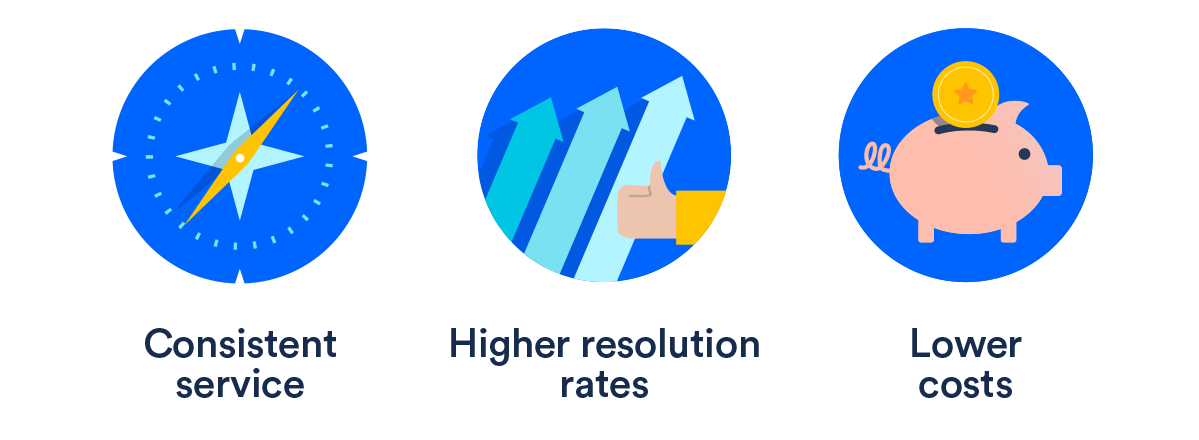What is IT support?
As technology evolves, knowledge will exist in more and more disparate places. Information gets stuck in email, social media interactions, forum discussions, comments, tickets, and even in the brains of individual service desk agents. If you don’t already have one, it’s time to aggregate your knowledge in a single repository or system.
What is a knowledge base?
A knowledge base is a self-serve online library of information about a product, service, department, or topic.
The data in your knowledge base can come from anywhere. Typically, contributors who are well versed in the relevant subjects add to and expand the knowledge base. The content can range from the ins and outs of your HR or legal department to an explanation of how a product works. The knowledge base may include FAQs, manuals, troubleshooting guides, runbooks, and other information your team may want or need to know.
Many knowledge bases are structured around artificial intelligence that can interact and respond to user input. Others are simply indexed encyclopedias. There are also machine-readable knowledge bases that store content in system-readable forms. Solutions are based on what we call automated deductive reasoning. When a user enters a query, software helps narrow down a solution.

A knowledge base is the foundation for your knowledge management practice. Knowledge management enables you to create, curate, share, utilize and manage knowledge across your whole company and across industries.
Why you need a knowledge base
In today’s connected world, people expect and demand easy access to accurate information. And to do that, they often aren’t willing to get on a phone call. Or send an email. Or file a service ticket. They want the answer they need immediately. Which is why you need a rich, deep knowledge base.
Organizations use knowledge bases for a lot of reasons. And they’re finding more uses virtually every day. The way you use a knowledge base depends, of course, on what your organization does and who it serves. But here are a few of the ways knowledge bases are proving to be invaluable to various teams.
- IT: It simplifies everything from troubleshooting to training/onboarding and general how-to and support questions
- HR: Again, great for everything from training/onboarding to distributing company policies and pay schedules
- Legal: Helps with contract and other approval processes, policies, trademarks and registrations
Benefits of a knowledge base
With a strong knowledge base and knowledge management practice, you’ll find your organization is more nimble and able to deliver faster service. You’ll also be able to improve self-service, give greater access to more articles, and offer regular updates through that knowledge management system.
Here are a few of the ways a knowledge base can make a difference for your organization:

More consistent service.
Everybody in your organization will reference the same playbook. Whether you’re in sales, IT, HR, or any other department, you’ll see the same information. This reduces confusion and enables teams to operate more consistently.
Higher resolution rates at first contact.
With a good knowledge base, there’s no need to put customers on hold, or transfer them between agents, or call them back later. Answers are right at customers’ fingertips. And when they have additional questions, others in the community are right there to help. It’s an easy-to-use, self-serve way to resolve issues fast.
Lower training costs.
A knowledge base, supported by a strong knowledge management program, ensures new hires are trained with the latest information and get consistent guidance. That translates to a better work environment and lower costs.
Once you put a good knowledge base in place, backed by a plan for knowledge management, customers and employees find answers themselves. So you can focus on the important aspects of your job, rather than answering everyone’s questions. If you aren’t already convinced of its value, a knowledge base can also:
- Organize everything people need to know in one place
- Standardize answers
- Make your company look smart, up-to-date, and professional
- Offer a feedback loop and the opportunity to engage with stakeholders
How to build your knowledge base
Beyond implementing a strong knowledge management system, here are tips on building and maintaining a knowledge base.
1. Determine that you need one.
Start by asking yourself how much time you’d save if employees didn’t have to answer the same questions over and over. Then look at your customer satisfaction and productivity goals; if your organization could do better, a knowledge base is a great place to start.
2. Get your content together.
This is no easy task -- content is everywhere. Collect FAQs (and answers) from any department that provides service. And we mean any department, like the guys who build trade shows, the people in IT, HR. Teams across the organization all can and should contribute to your knowledge base. And they should be part of the knowledge management process that maintains it.
3. Customize pages. Stay consistent.
Create a style guide, so that all of the information you pour into your knowledge base looks and sounds the same. This covers the entire visual presentation including font, type size, colors, and even images.
4. Find your voice and stick with it.
Figure out how your company or organization talks. Whether you’re polished or have kind of a laid back vibe, use that in the presentation of your knowledge base. The people in marketing can help.
5. Get the right tools to manage it.
Make sure you have the right tools for hosting and managing your knowledge base. Everything from the frequency of content changes to how customers typically interact with your information should be part of your decision.
6. Make it easy. And keep it that way.
Once it’s up and running, remember that your knowledge base is a self-serve operation. You’ll need to make sure your knowledge base is easy to navigate. And easy to use. Allow contributors to use speed-templates to upload data. Use labels and search terms to categorize information and make articles easier to find. Organize the content to fit your organization and then be careful to maintain it.
7. Keep it relevant. And up to date.
This is where the creation of your knowledge base flows into the ongoing task of knowledge management. Implement a system of analytics, so you understand how people are using your content. Allow users to leave feedback and ratings. Make sure your management and marketing people have a say in managing the knowledge base. Avoid delays and bottlenecks by identifying multiple people to approve content. Set up gatekeepers, then empower them to act when information needs to be dropped, added or changed.
Summary
Today, customers, employees––virtually everyone––wants and expects easy access to information. That data is locked away in the files, databases and minds inside your organization. Organizing it into a knowledge base opens the door to improved customer service, greater productivity, increased collaboration, and a lot less time spent answering the same questions. You can deliver an even better customer experience, one designed for the information-rich world we all live in.
Want to learn how knowledge management works in Jira Service Management?
The Total Economic Impact™ Of Atlassian For ITSM
The Total Economic Impact™ of Atlassian Jira Service Management. The report includes cost savings and business benefits enabled by Jira Service Management.
Read the whitepaperAtlassian's guide to agile ways of working with ITIL 4
ITIL 4 is here—and it’s more agile than ever. Learn tips to bring agility and collaboration into ITSM with Atlassian.
Read the whitepaper